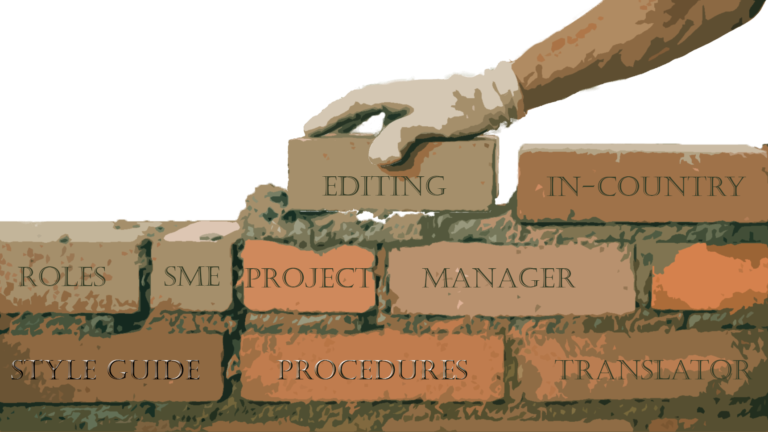Brick-by-brick
September 21, 2020 Laura Moats

Foundations for a Successful Translation Review
Your material was translated. You, the reviewer, and the company want the product to be perfect, but multiple review iterations are costly and can delay a project. How do you keep costs in line, projects on track, and produce a well-organized and well-executed localization strategy?
- Begin by developing robust quality assurance (QA) procedures that identify each person’s role and responsibility at each stage of the review.
- Make sure you have a translation glossary and follow company style and branding guides to ensure consistency. Just like copy editing, translation is to some extent preferential.
- Most importantly, everyone involved in the review process must understand his or her role.
There are three major roles in any document review process. Sometimes these roles consist of multiple people, but their functions in the review process remain the same.
Project manager
This role can be held by an instructional designer, a technical writer, or a project manager. Sometimes you will have one of each on the team. This role is responsible for translation integration, keeping the project on track, and ensuring the quality and consistency of the final output. Many translation vendors can manage the entire elearning or document integration, but someone on the company side must manage the entire project.
Translation service
This is the service or person who translates your materials. The scope of this role varies depending on whether you are using a translator or a translation service. If you use a service, the extent of the vendor’s role depends on how much of the integration the vendor performs.
In-country reviewer
To avoid disastrous translations, content must be carefully reviewed in the target language. This is commonly referred to as an in-country review. The review does not need to occur within the boundaries of the target country, but the reviewer must be someone who speaks the translated language extremely well ─ ideally, a native speaker.
This reviewer can consist of multiple people. One person could serve as both the technical reviewer and translation reviewer, or multiple people can perform various aspects of this role. It is possible you will need to hire an outside source for the language review. This person would liaise with an in-house subject matter expert (SME).
Process
Although it sounds wonderfully efficient for multiple people to access a document and revise it simultaneously, the process can get quite confusing. I prefer an iterative review process. Nothing is more wasteful than trying to review a moving target.
- When the material leaves your hands, do not touch it again until it returns! If there are changes you must make, keep a list. The person who is working on the material should be looking at the most current material, not version 1 of 10.
- Make sure your review process clearly defines what each person in the process must consider at each review iteration. For example:
- Proofreading belongs in the first review iteration. You should not be proofreading in the final iteration when the material is published. That iteration is for technical issues.
- The SME should not act as copyeditor. Catching a spelling error is fine. Combing the materials like an editor is a waste of the SME’s time, often results in revisions that do not meet the company’s style mandates, and takes the SME’s focus away from ensuring the materials are technically accurate.
When each person understands his or her role in the review process and adheres to their roles by following established guidelines, you are well on your way to successfully localizing your materials.
